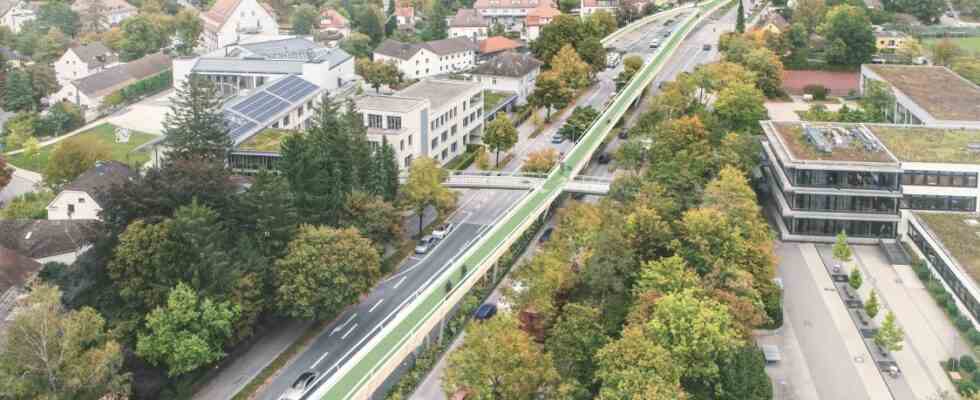The Swiss company urb-X thinks big. There you lift “traffic to the sky” and change the world at the same time. Haar’s Mayor Andreas Bukowski (CSU) is also known to be open to new ideas and visions. And so he has found a partner in the masterminds from Basel, with whom his idea, presented a year ago, of an eleven-kilometer-long “highway” for cyclists, elevated at a height of five to six meters, that runs in the middle of the B 304 from Vaterstetten could go as far as Munich, should now be more specific. Bukowski knows he is in agreement with the CSU mayor from Vaterstetten, Leonhard Spitzauer, and the district committee chairman of Trudering-Riem, Stefan Ziegler (also CSU). But in Haar itself, not everyone thinks what their mayor is thinking is so great.
In any case, Bukowski’s project did not pass the first real public test on Tuesday evening in the municipal council’s building committee. Since presenting his idea of a “fast cycle path” to the press a year ago, he has mainly spoken to representatives of local companies, who then praised Bukowski for his innovative spirit. For some in the community, however, that seems to be going too far. As it became known on Tuesday, there was some resentment because the mayor was selling things as projects that were not even officially an issue. That’s why the whole thing came up in the committee, where Bukowski campaigned to set up a working group so that everyone is informed from now on. But the SPD and the Greens didn’t go along with it.
Many committee members made it clear in their statements that they consider Bukowski’s idea to be completely half-baked and a pipe dream. The Greens had already explained this in a statement after the mayor’s PR appearance last year, and now they are backing up their view with a 40-point questionnaire. First of all, a working group needs “reliable working principles,” said Ulrich Leiner (Greens) in the committee. They were completely absent. According to an optimistic estimate, the project will cost 40 million euros, but most likely significantly more, according to Leiner. Apart from the head of the district committee Ziegler, the signals for support from Munich are also poor. Katharina Dworzak (SPD) warned against significantly increasing the “barrier effect” of the B 304 with a five meter high, kilometer long post construction. Bukowski was not impressed by such objections. The project is anything but ready for a decision, he said, but it is a great step forward for the mobility turnaround, for climate protection and basically can be implemented quickly and is cheap to maintain. “It’s about inspiring people.”
Haar’s Mayor Andreas Bukowski wants to inspire people with his idea.
(Photo: Claus Schunk)
According to Bukowski’s description, the fast bike path would have two lanes in each direction and would be 4.4 meters wide overall. 5,000 cyclists could cycle there per hour from the Ebersberg district to Munich. On the left and right, the roadway, which had been heated as a precaution, would be flanked by solar modules at a lofty height, which also offer wind protection. The modules would have an output of up to one megawatt per kilometer and would make the entire transport project an energy gain. This would save 60 tons of CO₂ per year. The timber construction by the Basel company would also result in a 3,000 metric ton reduction in CO₂ emissions compared to conventional construction using concrete or steel. Every 500 meters up to a maximum of five kilometers, an access point would be created via a drivable helix on the B 304, similar to the one on the Arnulfsteg in Munich, only smaller. Bukowski summarized all this under the term “smart”. Smart construction, smart maintenance and so on.
But the mayor, who was followed only by the CSU parliamentary group and FDP municipal councilor Peter Siemsen, also had to admit that nothing has really been clarified yet. A year after the vision was presented, the State Building Authority, which is responsible for the B 304, has not even received a statement. The company, on whose patented modular design all considerations have been based, is initially planning a model route in Basel. The city of Munich, the MVG and the district are also discussing a tram line exactly where the cycle path should run. Bukowski thinks both are feasible at the same time. The cycle expressway could also be created, which the Greens are promoting along the railway line and for which resolutions have already been passed and funding applications have been submitted. So far, there have been no talks about how all this should be compatible, as was shown on Tuesday.
The elevated cycle path can allegedly be realized together with a tram line in the middle of the B 304.
(Photo: private)
Nevertheless, the members of the building committee did not reject the project in bulk, as the SPD demanded. The Greens prevailed with the plan to first clarify fundamental issues and to discuss them further in six months. So it is completely unclear how the access roads to the cycle path should be constructed. The Greens strongly doubt that there are answers that will make the whole thing appear realistic. Haar’s mayor still wants to try.

